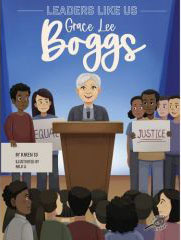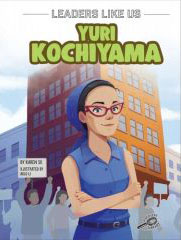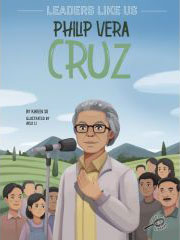Interviewed by Leonard Chan
Karen Su is a professor at the University of Illinois Chicago and is director of Undergraduate Studies for the Global Asian Studies department.
She has recently authored four children’s picture books on notable Asian Americans, including Grace Lee Boggs, Philip Vera Cruz, Yuri Kochiyama, and Dalip Singh Saund.
Thank you for agreeing to do this interview Prof. Su.
First off, tell us a little bit about your background and how you got into the field of Asian American Studies. Is there an interesting story about what inspired you to get into this field?
I grew up in Amherst, Massachusetts to Chinese American immigrant parents. I grew up thinking I had to be Chinese Chinese. I didn’t know what it meant to be Chinese American or Asian American.
When I got to high school, a group of older Asian American students who were about to graduate called a meeting for a few of us younger students. They told us that they had been working on a curriculum project to make sure teachers included Asian American history in our classes. That was the first time I even realized there was a history of Asians in the U.S. beyond my own family’s experience. That was the first time I realized I had never learned anything in school that was connected to my history as an Asian American. That was when I began to understand what it might mean to be an Asian American. That got me started on a path. I got involved in pushing for more Asian American studies in college. I was lucky enough to go to some Asian American conferences in high school and college where I got to learn more. Asian American Studies was transformative for me so I kept going. I’ve been involved in developing Asian American Studies programs and Asian American cultural centers at multiple colleges and universities in higher education over the last 3 decades. I still see how transformative it is for students! That’s what keeps me going.
Can you tell us about how you came to write these picture books?
I’ve been writing children’s books seriously for about 10 years. I’m working on many picture book projects that feature the life stories of Asian Americans with the goal of increasing the representation of Asian Americans in children’s books. I met J.P. Miller, a prolific author who wrote 14 biographies on African Americans for the Leaders Like Us series at a Highlights Foundation writing workshop on nonfiction picture books. She recommended me to the educational publisher when they decided to start a series on Asian Americans.
I was excited to take on the project because when my son was in fourth grade and focusing on a biography unit, there were no biographies in his classroom on Asian Americans. I wanted to change that.It was a full circle moment when I was able to do a school visit at my son’s former elementary school after the books were published. His former fourth grade teacher is still there and now I know these biographies on Asian Americans are there for students to choose from for their biography unit.
Illinois recently passed the IL TEAACH Act, or Teaching Equitable Asian American Community History Act, which mandates that Asian American history be taught in K-12 public schools. It’s a first step and I’ve been happy to see more teachers learning and incorporating Asian American literature and history into K-12 curriculum. I’m glad they might be able to use my books!
How did you decide on whom to write about? For our readers who have not read the books and may not know anything about these extraordinary Asian Americans could you give them a quick preview of who they are and why you think kids should know more about them?
The contract was to write four books to start the series. I looked at what was already available and there are books for children about political leaders like Kamala Harris or Tammy Duckworth so I wanted to write on important figures that may not have as many books on them yet. I based my choices for the first four people on important figures that I find inspiring. Most of my college students coming into an Intro to Asian American Studies class have not heard of these important Asian Americans so I want to change that by introducing them to younger readers. I wanted to make sure there was a range of ethnic backgrounds (Chinese, Japanese, Filipino, Indian) and I chose two women and two men. I chose people who have worked to make social change with other communities and people for whom justice mattered. Those are the kinds of leaders I’d like young readers to be inspired by and feel they, too, can pursue actions for social change and justice.
I chose Grace Lee Boggs who was a Chinese American woman. She was a community leader in Detroit who was a Marxist revolutionary and active in the Black power movement with her husband James Boggs. Philip Vera Cruz was a Filipino American man, a migrant laborer who became a union organizer and leader, working with other Filipino farmworkers to start the Delano grape strike and boycott. He became vice president of the United Farm Workers and worked with Cesar Chavez and Dolores Huerta. Often people who are familiar with UFW still don’t know about the role Filipino farmworkers played. I noticed there are a few books on Larry Itliong, so I decided to write about Philip Vera Cruz.
For the second two books, I decided first on Yuri Kochiyama because nowadays, if there’s Grace Lee Boggs, people will be looking for Yuri Kochiyama. They are different kinds of leaders, but as they have become prominent many people think of them together. Kochiyama was Japanese American and she and her family were incarcerated during WWII, which I think is important for young readers to learn about so I wanted at least one of the first four books to include that history. Kochiyama was mother of 6 children raised in Harlem NYC. She and her husband Bill Kochiyama worked on Redress and Reparations. But Yuri Kochiyama also became active in the Blackpower movement, working with Malcolm X, she also protested for Puerto Rican independence, and she was a longtime supporter of political prisoners’ rights.
Then I chose Dalip Singh Saund to have a South Asian because many people sometimes still aren’t sure if South Asians are part of Asian American umbrella so I wanted that to be clear. Dalip Singh Saund was the first Asian American to be elected to Congress and was an Indian American and was the first, and I think still the only Sikh American. I found his dedication to trying to improve communities from the time he was in India to his time in the states to be inspiring.
What I think is important for kids to see in these four leaders is that they didn’t just fight for Asian Americans. They lived and worked in and fought alongside many communities. I think that’s really important for both Asian American and non-Asian American kids to know.
Were there others that you considered and might there still be a chance that you will get to write about them in the future?
I have a very long list of others to write about for future biographies if I get the opportunity. Too long a list to name specific people right now, but I would like to include Asian Americans from more ethnic backgrounds – Korean, Southeast Asian, more South Asians, mixed race heritage, and adoptees. And I would like to include LGBTQ Asian Americans, Asian Americans with disabilities, and more. I hope I will get the chance to write more Leaders Like Us books, but I’m also working on and hope to publish other picture books that will hopefully reflect these rich diversities within the Asian American community.
The complete biographies of these individuals could fill whole adult level books. How did you decide on what to cover about them? What are some of the things that you wish you could have gotten into the books that didn’t make it? Are there some things that you learned about them during the course of writing these books that surprised even you?
The publisher had a template with which to work with that was developed and honed by J.P. Miller as she wrote the many biographies of African American leaders. You may have noticed that each book’ first chapter starts with a key question to bring in the reader, then a flashback to an important moment in the person’s life. The second two chapters follow their milestones and the ending highlights their legacy and a quotation. Because there was a word limit and it’s written for 2nd-4th graders, I did leave some things out. It was hard to choose. But for Grace Lee Boggs, for instance, I do not go into her involvement with Marxism and CLR James. I chose to emphasize her connection with Malcolm X and Martin Luther King, Jr., civil rights figures whom 2nd-4th graders are more familiar with. For Yuri Kochiyama, I wanted to highlight more of the political prisoners she supported by name, such as Mumia Abu-Jamal. But a side bar on political prisoners was not included. For Dalip Singh Saund, however, I insisted we must have a note about anti-Sikh hate violence post-9/11 so it was added in as a sidebar.
I was surprised to find out things like Dalip Singh Saund keeping a suit in his car to change into to go give talks while the crops were being watered. I also really like learning about how Yuri Kochiyama was a prolific letter writer and stayed up late at night to write. I was surprised to learn that Philip Vera Cruz was born on Christmas Day. For Grace Lee Boggs, I really liked learning how her favorite question to ask people was “What time is it on the clock of the world?” and also that she liked to give people lots of books to read.
The thing that stands out most to me about all four figures is their determination to keep fighting the good fight into their old age. I admire them for that as I am aging and find myself feeling more tired in my advancing years. It makes me wonder how they kept going so strong in their elderly years!
I found it interesting how the people you wrote about had some similar experiences. For example, Grace Lee Boggs and Yuri Kochiyama both knew people like Malcolm X and held community meetings in their homes. Philip Vera Cruz and Dalip Singh Saund both worked in the canneries and on farms. All four of them fought to make their communities better. Could you find any records of their paths crossing and meeting? All four wrote about their experiences. In your research on them, did they ever mention or acknowledge the activities of the others that you wrote about? Even if they didn’t, were their similarities, but different paths to their life’s work what you wanted to highlight with your books?
I love that you see these connections and have highlighted them. I do think the overlaps between some of them are fascinating and was a draw to me. I didn’t find any evidence of Philip Vera Cruz and Dalip Singh Saund crossing paths, but films and photos show Yuri Kochiyama and Grace Lee Boggs did appear at some events together.
I’m not sure if I have a question regarding the following, but I once met someone that was a regular at one of those communities meeting at Yuri Kochiyama’s home. He spoke glowingly of her leadership and participation in the meetings. I guess I found it interesting that activism can start in as simple of a place as one’s own home and community and can rise to such notoriety as these individuals that you write about. Perhaps it’s not as important that they became famous, but that we too can do simple things in our communities to make a difference. You mentioned in the Grace Lee Boggs book that she came to believe this very idea. Could you elaborate more on this so that those that may read this will know that they too could make a positive difference?
That’s so cool that you met someone who attended meetings at Yuri Kochiyama’s home! Yes, I like your insight about how activism can start for someone wherever they are. And I agree that it’s not as important to gain fame, but to keep doing things in our communities that make a difference. Grace Lee Boggs emphasizes that anyone can become a solutionary, someone who helps solve problems. She also wanted education to focus on students working in their communities rather than putting students in a building for 12-16 years separate from their communities. I think there are a lot of people in the communities where Grace Lee Boggs, Yuri Kochiyama, Philip Vera Cruz, and Dalip Singh Saund lived and worked who may not be famous at all, but they were active and did important things. Also, small actions may have big impact. Adrienne Maree Brown who was very influenced by Grace Lee Boggs writes in her book Emergent Strategy that “How we are at small scale is how we are at large scale.” I think everyone really needs to take that to heart and live and act as if what we do every day, all of our small actions,will make a difference in changing our world for the better.
When I have gone to schools to present on the books, I love finding out how the students connect. I have had kids come up to me to proudly share that they are Filipino or Chinese or adopted or how they connect in some other way to the biographies. When I have asked them the question “What is a world problem youwant to help solve?” everyone has an answer—gun violence, global warming, world peace, racism, sexism, hunger—and everyone is ready to talk with each other about it. That gives me tremendous hope!
Thank you very much for answering our questions and writing your books.
You’re very welcome. Thanks for your thoughtful and insightful questions!
Copyright © 2024 by AACP, Inc.



